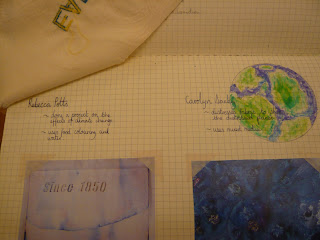
we have undertaken a peer aseessment where everyone in the class had to write a strength and an improvement for everybody elses outcome in relation to how well it fits in with their sketchbook. Mine was the canvas for summer with the hand emboidered leaves. My comments were...
*really like it, think you could maybe do 3 more in different colours so you have one for each season.
*really good, i think that you should do them for each season. add more sewing to make it fuller.
*I love the hand embroidery leaves and the texture and depth to the paint. Bigger? Longer? Size? Colour?
*I like the plan and resarch in the sketchbook. i think you could sew material leaves onto it.
*Love the simplicity. Few sketches.
I then presented it onto a page using green post-it notes cut into the shapes of leaves.

















































